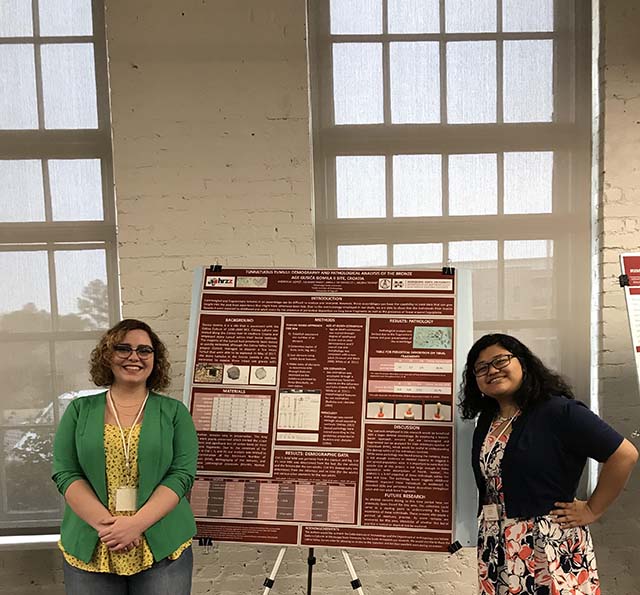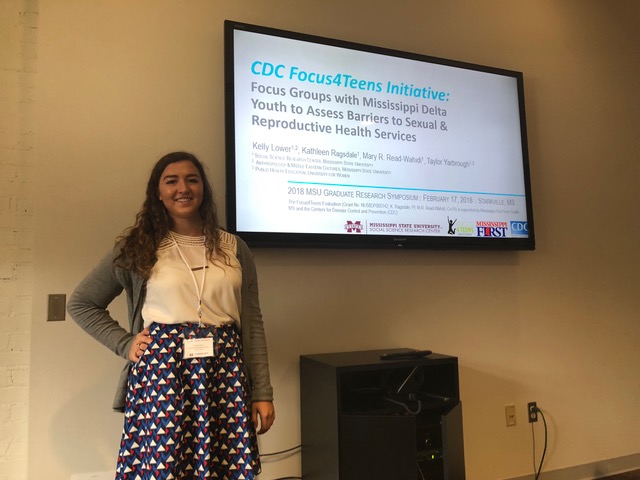AMEC graduate students participated in the 2018 GSA Symposium!
Andrea Lopez and Julianne Paige placed first in the poster session.
Title: Tumultuous tumuli: Demography and pathological analysis of the Bronze Age Gusića Gomila II site, Croatia
Abstract:
Gusića Gomila II, a site associated with the Cetina culture of 2200-2000 BCE, was uncovered near the town of Trilj. Human remains were excavated from a stone tumulus which contained 3 intact graves in situ, designated as Cist I (MNI=2: 1 adult male, 1 non-adult), II (MNI=4: 1 adult male, 1 adult indeterminate, 2 non-adults), and III (MNI=3: 1 adult male, 1 adult indeterminate, 1 non-adult). Commingled and fragmentary remains present challenges for analysis and interpretation. These assemblages can provide data on past lived experience that might otherwise be lost. The methodology used concentrates on elements rather than individuals. Pathological conditions cannot be traced between elements of a specific individual, but the presence of pathological changes indicate the population as a whole was exposed to disease vectors and/or experienced stresses as part of daily life. The study of the long bone fragments showed periosteal deposition in both adults and non-adults. Linear enamel hypoplasia (LEH) was found on 5 of 23 teeth (22%). The teeth with LEH (2 of 5 or 40%) exhibited multiple LEHs, indicating recovery incidences of stress during dental development. The scope of analysis is limited by the nature and preservation of the assemblage, but we show the population from Gusića Gomila II was exposed to both childhood and adult stress. The limited skeletal material from this time period and location, demographic and pathological analysis of this assemblage begins to build an understanding of lived experience in Bronze Age Croatia.

Kelly Lower also participated in the GSA Symposium
Title: CDC Focus4Teens Initiative: Focus Groups with Mississippi Delta Youth Assess Barriers to Sexual & Reproductive Health Services.
Abstract: 249 words
Objective: Focus4Teens is a CDC-funded initiative to reduce teen pregnancy in the Mississippi Delta. While Mississippi’s teen birth rate (34.8 per 1,000 girls aged 15-19) ranks 2nd in the nation (PTD, 2018), the Mississippi Delta counties of Coahoma, Quitman, and Tunica have a combined teen birth rate of 58 per 1,000 (MSDH, 2016). Although highly effective long-acting reversible contraception (LARC) is recommended for youth (American Academy of Pediatrics, 2014), under 1% of girls aged 15-19 seeking contraception at Mississippi Title X sites received LARC—the lowest percentage in the nation (CDC, 2015).
Methods: The Ecological Model (Rimer et al., 2005) informed development of the YR1 Youth Focus Group protocol to assess barriers to seeking sexual and reproductive health services (SRHS) among rural Mississippi Delta youth, preferred attributes of youth-friendly SRH providers, knowledge of LARC/other birth control, and experiences engaging in SRH conversations with parents.
Key Findings: Thirty-five 14-19 year olds (97% African American, 77% female) participated in three mixed-gender focus groups. Emergent themes associated with SRH barriers include that teens lack 1) confidence that—in rural communities where “everybody knows everybody”—SRH providers can/will ensure the privacy and confidentiality of teens seeking SRHS, 2) knowledge regarding their right to SRHS without parental consent, 3) knowledge regarding LARC/other birth control, and 4) positive experiences around SRH communications with parents.
Conclusions to Date: Results reinforce the need—from teens’ perspectives—for a coordinated system for identifying, referring, and providing evidence-based youth-friendly SRHS, including coordinated outreach for teens, parents, and SRH providers.
